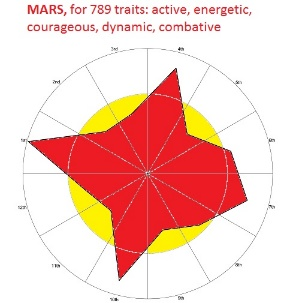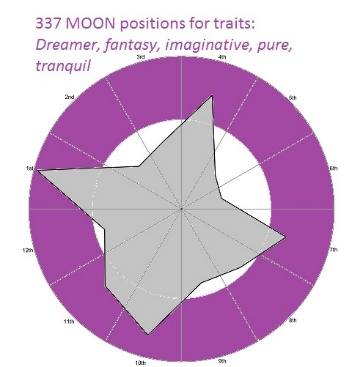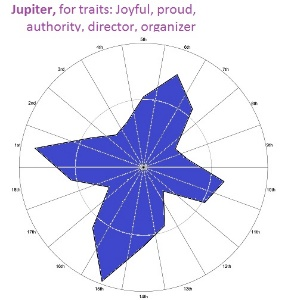Re-evaluating the Gauquelin Data
PAGES
- Introduction
- Expected and Observed planetary frequencies in the Gauquelin professional groups
- The Ertel Enigma
- Report by the French Skeptics, 1982-96
- The Work of Arno Müller
- From the Archives
- Synastry Effects in the Gauquelin 'Heredity' Data
- Poets and the Moon
- Character traits
- Venus
- Database of Character-Traits
- Introvert-Extravert
- Physicians and Sports Champion Data
- Where's the Data?
- Was It Significant?
- A Fourfold Effect
- The Shape of the Gauquelin Professional-Data Effect
- Astro-Psychological Problems
- Françoise and Michel, a Productive Partnership
9. Character traits
"...the inborn character of these famous people is more tightly correlated to their birth planets than their professional success."1
Wrote Francoise Gauquelin, and likewise Michel had concluded in 1983:
"...the relationship between planet and character-trait could be observed without any need to take account of the professions." 2
To ascertain this, the Gauquelins and a team of helpers extracted lists of character-traits (nouns and adjectives) from brief biographies, which can usually be found for famous people3. They did this for four professional groups, and published their results (in the early 1970s) as these eight volumes:
C2 Mars and Sports Champions — A1 Sports champions
C3 Saturn and Men of Science — A2 Scientists and Physicians
C4 Jupiter and Actors — A5 Actors and Politicians
C5 The Moon and writers — A6 Writers and Journalists
The 'C' volumes give the character-trait lists and 'A' gives the birth-data.
We here follow John Addey's approach, of only examining a small number of traits per planet. Thus he wrote:
"...the word ENERGETIC was attributed to 187 different people (94 champions, 34 scientists, 42 actors, 17 writers)"4
Those numbers tell us how many times that adjective scored in the 'brief biographies,' for the four professional groups. You can check these numbers on the data-set extracted from the above volumes.
Selecting just five traits - for each of the four planets the Gauquelins worked with - the data was scored:
Moon: Imaginative, fantasy, dreamer, tranquil, pure
Mars: Courageous, active, energetic, combative, dynamic
Jupiter: Authority, jovial, director, organizer, pride
Saturn: Solitary, deep severe cold, silent.
The traits are here given in sequence of how often they were cited, for example 'courageous' appears first in the Mars-list because it was scored for 231 biographies, whereas 'dynamic' was found only 56 times (Five allegedly-Venus-traits have also been included, in this data-set). The general idea is that adjectives should have been cited at least fifty times, the exception here being 'pure' for the moon, cited only 44 times.
The patterns appear as strongly fourfold: concerning the Mars distribution here shown, John Addey remarked that 'the pure 4th harmonic qualities (active, energetic etc)'
showed no longer any tendency for there to be stronger peaks after the rise and culmination; all four angles are more or less equal in strength. (Ibid p.125)
That is very different from the traditional Gauquelin effect. These character-trait effects appear as larger than for the professional groups. People agree upon the Mars-traits, whereas others provoke dissention, eg some feel 'authoritative' and 'director' should be Saturnine rather than Jovial.

The twenty-one trait words here selected were scored almost two thousand times, from among the four professional groups (see Table). We give the complete data-source here5. To view it, right-click and then 'save as' into a text file, then open that up into a spreadsheet file eg Excel or Libre Office. One can then select any group of adjectives. The first three columns give profession, assumed-planet and character-trait - delete these when getting the data into a suitable format for, eg, the Jigsaw or Sirius program.
The other columns show name, year, month, day, hour and minute of birth, followed by timezone, place of birth, longitude and latitude6. To select the character-traits for one planet, sort the second column, then extract eg all the rows that belong to 'Mars.' These are character-traits that allegedly belong to Mars. Some names appear more than once because they have more than one trait.
The data here given has these numbers of character-traits:7
| Professional Group | Lunar | Martial | Jupiter | Saturnine | Total |
|---|---|---|---|---|---|
| Writers (2027) | 154 | 116 | 87 | 130 | 487 |
| Scientists (1094) | 41 | 182 | 129 | 99 | 451 |
| Actors (1409) | 81 | 175 | 141 | 89 | 486 |
| Sports (2089) | 61 | 316 | 82 | 39 | 498 |
| 337 | 789 | 439 | 357 | 1922 |
Plotting the lunar character-traits give:

The maxima appear in 'cadent' houses. These in the Placidus house-system are numbered 3, 6, 9 and 12, while as Gauquelin sectors (counted clockwise) they are the 1st, 4th, 7th and 10th. As Francoise remarked:
Each time statistically significant results showed up, they were maximal in those so-called "cadent houses". Present day traditionalists are shocked by these statistical results in Cadent instead of Angular houses. 8
If we compare the scores in 'cadent' houses with the others, the lunar traits gave huge a 79% excess. The angle of the Moon at time of birth, has this big effect, upon character. The Mars-traits likewise showed a 75% excess with Mars. The Saturn keywords scored only a fifty percent excess, especially as Saturn reached the MC.
Here is a rather charming quote from John Addey about the lunar traits:
How often we find, in the lunar spectra, words which are used of the Moon itself (pure, chaste, clear, silent, secret, lucid, brilliant, cold, light, abundant or fertile) or which are used in relation to watery surfaces (tranquil, reflective) or which refer to the image-forming capacity so often attributed to the moon, to water and to silver (imaginative, fancy).9

Sometimes the Gauquelins used an 18-fold division of the diurnal circle rather than twelve. Here are some Jupiter-traits plotted in this manner. These show a 68% excess in the four 'cadent' houses. These five traits came from John Addey - whereas the Jupiter-list of traits given by Francoise Gauquelin in her Personalities of the Planets (1982) did not include director or organizer. Astrologers consulted were doubtful about these keywords. Removing them one at a time showed 'authority' to be a strongly Jupiter keyword, whereas the other two were weak.
The three keywords joyful, proud and authority were found 301 times in biographies (as you can check in the enclosed data). Their natal charts scored 86% more for Jupiter in the cadent houses, than in the others; which is remarkable. In contrast the two keywords organizer and director (found in 152 biographies) only showed a 41% excess i.e only half as much.
It is counter-intuitive to group together joyful, proud and authority; in contrast with the Martial and lunar traits here used, which cohere together. Other keywords that could here be tried are ambitious, personality, popular and self-confidence.
Addey, the great Pythagorean philosopher, was towards the end of his life looking at a couple of hundred keywords, in the way here shown. All records of the computerized study of trait words done around 1980 by John Addey, the Gauquelins, Tom Shanks and Neil Michelson in San Diego (Astro-Computing Services) have alas been lost. This remains as a challenge for the future. Dismissive comments on the CTH (character-traits hypothesis) made by Ertel & Dean appear as having been premature.
For a more recent (2017) evaluation of the Mars character-traits, see my article Is Mars passionate? Trait Adjectives from the Gauquelin Data in the 'ISAR International Astrologer' journal.
- FG, APP March '92 'MG In Memoriam' p.5.
- M Gauquelin The Truth about Astrology, 1983, p.63.
- MG, Ibid, p.53.
- JM Addey, A New Study of Astrology, 1996, p.118.
- All this data has been checked by programmer Sven Rafael.
- Hours and minutes, longitude and latitude, came from the CURA website. On the rare occasions where the CURA date diverged from that given by the Gauquelins, we preferred the latter.
- The Table represents 826 people, each having several character-traits.
- FG, APP September 1992 p.21.
- Addey, Ibid, p.167.